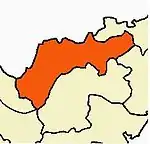Arungundram
Arungundram (also spelled Arunkundram) is a village in Tamil Nadu between Arcot and Kannamangalam. The village is surrounded by hillocks and paddy fields, and is about 8 km from Arcot in Vellore district. Agriculture is the backbone of the village. The village people are dependent on the North East Monsoon and the Palar river for irrigation.
Arungundram | |
|---|---|
village | |
 Arungundram Location in Tamil Nadu, India  Arungundram Arungundram (India) | |
| Coordinates: 12.9°N 79.3333°E | |
| Country | |
| State | Tamil Nadu |
| Elevation | 163 m (535 ft) |
| Languages | |
| • Official | Tamil |
| Time zone | UTC+5:30 (IST) |
History
During the rule of Pallava dynasty (400 - 800 AD), Arungundram was a place of busy activities. Jain Monks and Nuns lived in the hillocks near Arungundram. Thiruppan Malai, in the outskirts of the village, had a dormitory of Jain Nuns. There are seven cave temples in the hills, belonging to Nandivarma Pallava period (740 AD). The hillock and the caves are now known as "Panchapandavar malai" in Tamil. There is also a cavern atop the hill with a spring. Sculpted figures of the famous monk Naganandhi and a Jain Yakshi are seen near the spring. An inscription near the figure says "Naranan has carved the figure of Pon Iyakki (Yakshi) for his guru Naganandhi during the reign of Nandivarma Pothatharasar ..."
Another inscription belonging to Chola period tells about the donation of a village Kooraganpadi, by a kind of Lada country, Veeracholan and his queen. Hearsay tells about a palace at the Malligai Medu village (Lalaimedu) to the west of Arungundram. It is also believed that there existed 108 Siva temples in and around Arungundram village and the hills. Even now one can see remnants of Siva temples and lingams scattered all around the paddy fields of Arungundram.
These temples are believed to have been damaged during the Carnatic War between Arcot Nawab Chanda Saheb and East India Company in the middle ot 18th century. The invasion of Hyder Ali is also believed to have caused major damage to the temples around Arcot including Arungundram.
A dilapidated temple of Siva, Sri Chandramouleeswarar Temple atop Hariharan Kundram, near Arungundram village, a temple of Sri Dharmeswarar at the heart of the village and a temple of Sri Venugopalaswamy still exist in spite of invasions and wars.
The Ponniamman temple with shrines for Saptha Matrikas is revered as the Guardian Angel of the village and a footprint of the Ponniamman on a rock is still worshipped by the villagers.
Later history
After the Arcot wars, most of the villages of erstwhile North Arcot districts were badly ruined. People began migrating in search of jobs, safety, education and to preserve their culture. A few joined the army of Arcot Nawab and East India Company, and others continued to work for daily wages in nearby Vellore and Wallajab.
Years later, the descendants of those who left Arungundram two centuries before returned to the village after hearing stories of its beauty from parents and grandparents. Some were high-ranking officials in their respective professions and settled well in their lives. They visited the village many times, and grew to love their ancestral village so much, they resolved to restore its former glory.
Recent developments
Hariharan Kundram Public Charitable Trust which was created by the people returning to the village had created a free maternity hospital for the poor people of the village for conducting deliveries and was opened on 14 June 2008 by the collector of Vellor district Thiru Dharmendra Prasad Yadav I.A.S. The hospital is also being used by the government for providing immunization for children and ante natal checkups for pregnant women on every third Tuesday of the month. A free library and a computer training center have also been built. 10 solar lamps have been provided for the villagers. Every second Sunday, a team of doctors from Chennai travel to the village to provide free medical consultation and medicines.
A primary school building with four class rooms was constructed in the existing panchayat school premises utilizing MP funds
